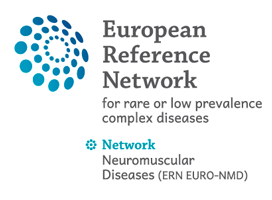09 Jan 2019
Assessment of disease progression in dysferlinopathy: A 1-year cohort study.
Authors:
Ursula Moore, Marni Jacobs , Meredith K James, Anna G Mayhew, Roberto Fernandez-Torron , Jia Feng , Avital Cnaan , Michelle Eagle , Karen Bettinson , Laura E Rufibach , Robert Muni Lofra, Andrew M Blamire, Pierre G Carlier, Plavi Mittal, Linda Pax Lowes, Lindsay Alfano, Kristy Rose, Tina Duong, Katherine M Berry , Elena Montiel-Morillo , Irene Pedrosa-Hernández, Scott Holsten, Mohammed Sanjak, Ai Ashida, Chikako Sakamoto, Takayuki Tateishi , Hiroyuki Yajima , Aurélie Canal , Gwenn Ollivier , Valerie Decostre , Juan Bosco Mendez , Nieves Sánchez-Aguilera Praxedes, Simone Thiele, Catherine Siener, Jeanine Shierbecker, Julaine M Florence, Bruno Vandevelde, Brittney DeWolf, Meghan Hutchence, Richard Gee, Juliana Prügel, Elke Maron, Heather Hilsden, Hanns Lochmüller, Ulrike Grieben, Simone Spuler, Carolina Tesi Rocha, John W Day, Kristi J Jones, Diana X Bharucha-Goebel, Emmanuelle Salort-Campana, Matthew Harms, Alan Pestronk, Sabine Krause, Olivia Schreiber-Katz, Maggie C Walter, Carmen Paradas, Jean-Yves Hogrel, Tanya Stojkovic, Shin’ichi Takeda, Madoka Mori-Yoshimura, Elena Bravver, Susan Sparks, Jordi Díaz-Manera, Luca Bello, Claudio Semplicini, Elena Pegoraro, Jerry R Mendell, Kate Bushby, Volker Straub, Jain COS Consortium
Objective
To assess the ability of functional measures to detect disease progression in dysferlinopathy over 6 months and 1 year.
Methods
One hundred ninety-three patients with dysferlinopathy were recruited to the Jain Foundation’s International Clinical Outcome Study for Dysferlinopathy. Baseline, 6-month, and 1-year assessments included adapted North Star Ambulatory Assessment (a-NSAA), Motor Function Measure (MFM-20), timed function tests, 6-minute walk test (6MWT), Brooke scale, Jebsen test, manual muscle testing, and hand-held dynamometry. Patients also completed the ACTIVLIM questionnaire. Change in each measure over 6 months and 1 year was calculated and compared between disease severity (ambulant [mild, moderate, or severe based on a-NSAA score] or nonambulant [unable to complete a 10-meter walk]) and clinical diagnosis.
Results
The functional a-NSAA test was the most sensitive to deterioration for ambulant patients overall. The a-NSAA score was the most sensitive test in the mild and moderate groups, while the 6MWT was most sensitive in the severe group. The 10-meter walk test was the only test showing significant change across all ambulant severity groups. In nonambulant patients, the MFM domain 3, wrist flexion strength, and pinch grip were most sensitive. Progression rates did not differ by clinical diagnosis. Power calculations determined that 46 moderately affected patients are required to determine clinical effectiveness for a hypothetical 1-year clinical trial based on the a-NSAA as a clinical endpoint.
Conclusion
Certain functional outcome measures can detect changes over 6 months and 1 year in dysferlinopathy and potentially be useful in monitoring progression in clinical trials.
ClinicalTrials.gov identifier: NCT01676077.

